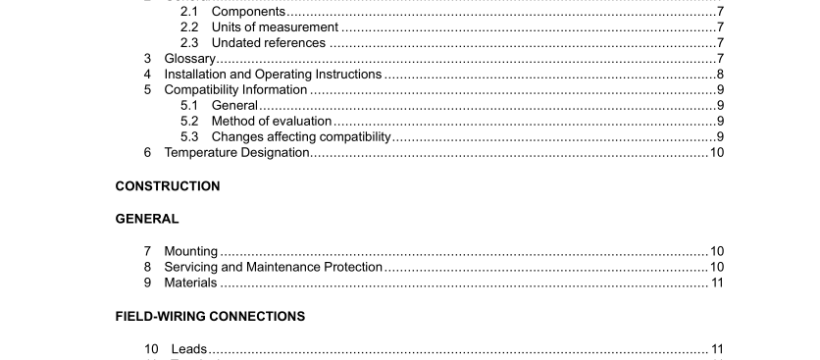UL 521-2019 pdf download.Heat Detectors for Fire Protective Signaling Systems.
3.3 COMPONENT, RELIABLE – An electrical component that is not expected to fail or be periodically replaced and is not supervised. A reliable component shall have a predicted failure rate of 2.5 or fewer failures per million hours as determined for a “Ground Fixed” (GF) environment by MIL-HDBK 217B, or equivalent (see Supplement SA). 3.4 ELECTRONIC-TYPE HEAT DETECTOR – A device that uses electronic circuitry to respond to an abnormal high temperature or rate of temperature rise. 3.5 FIXED-TEMPERATURE TYPE HEAT DETECTOR – A device that will respond when its operating element becomes heated to a predetermined level. The temperature of the air surrounding the device at the moment of operation will vary, depending on the rate at which the temperature is rising. 3.6 HEAT DETECTOR – A device that detects an abnormal high temperature or rate of temperature rise. 3.7 HEAT-SENSITIVE CABLE – A line-type device whose sensitive element comprises two current- carrying wires held separated by a heat-sensitive insulation that softens at the rated temperature, thus allowing the wires to make electrical contact. 3.8 LINE-TYPE HEAT DETECTOR – A device in which detection is continuous along a path. 3.9 NONRESTORABLE HEAT DETECTOR – A device whose sensing element is intended to be destroyed by the process of detecting a fire.
3.10 RATE-COMPENSATION HEAT DETECTOR – A device that will respond when the temperature of the surrounding air reaches the predetermined level, regardless of the rate of temperature rise. 3.11 RATE-OF-RISE HEAT DETECTOR – A device that will respond when the temperature rises at a rate exceeding a predetermined amount. 3.12 RESTORABLE HEAT DETECTOR – A device whose sensing element is not destroyed during intended service by the processes of detecting a fire. Restoration may be manual or automatic. 3.13 SELF-RESTORING HEAT DETECTOR – A restorable detector whose sensing element is intended to be returned to normal automatically. 3.14 SPOT-TYPE HEAT DETECTOR – A device whose detecting element is concentrated at a particular location. 3.15 TWO-WIRE DETECTOR – A detector that signals over and obtains its power from the initiating device circuit of a fire alarm system control unit. Additional terminals or leads may be provided for annunciation or control of supplementary functions. 4 Installation and Operating Instructions 4.1 A copy of the installation and operating instructions and related schematic wiring diagrams and installation drawings shall be used as a guide in the examination and test of the detector. For this purpose, a printed edition is not required. The information may be included in a manual or technical bulletin.
5 Compatibility Information 5.1 General 5.1.1 Compatibility between a two-wire electronic heat detector that receives its power from the initiating device circuit of a fire alarm system control unit is dependent upon the interaction between the circuit parameters, such as voltage, current, frequency, and impedance, of the detector and the initiating device circuit. 5.1.2 A detector that does not receive its power from the initiating device circuit of a control unit (conventionally a detector having four or more wires for field connection or a heat detector with dry contacts) may be employed with any electrically compatible fire alarm system control unit without the need for compatibility consideration as its connection does not impose any load on the initiating circuit. Under an alarm condition, the four-wire detector acts as a switch (similar to a manual station) to place the system in alarm. 5.1.3 As a two-wire detector obtains its power from the initiating device circuit of a system control unit, its operation is dependent on the characteristics of the circuit to which it is connected as the detector imposes a resistive and capacitive load on the circuit. Similarly, the load imposed upon the initiating circuit by a connected detector must not prevent alarm response by a control unit to a detector in alarm, nor prevent a trouble response to an open circuit after the last detector.UL 521-2019 pdf download.
UL 521-2019 pdf download
